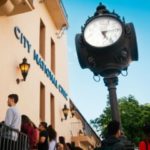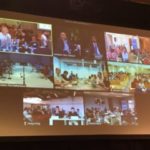
What exactly do DMOs do? What is their purpose in today’s knowledge economy when so much information is available online? Questions about the role of destination marketing organizations have become louder in the meetings industry in the past few years, because growing numbers of planners are sidestepping DMOs and working directly with venues, hotels, and other suppliers and vendors.
In an effort to empirically identify and augment the value proposition of DMOs, Destination Marketing Association International (DMAI) has undertaken a comprehensive research study called DestinationNEXT, unveiling phase one of the project at its 2014 Annual Convention last summer. Phase two will launch at DMAI’s 2015 conference in Austin this July.
“We wanted this to be a very provocative and transformational report with practical recommendations about how DMOs should move forward,” said Paul Ouimet, executive vice president of Vancouver-based InterVISTAS Consulting Group, which is conducting the DestinationNEXT project for DMAI. “For phase two, we’ll have case studies of DMOs that are doing a great job in several key areas of interest to meeting planners, such as boosting delegate attendance, increasing corporate sponsorships, expanding exhibitor participation, and generating deeper legacy impacts of events.”
The upshot of DMAI’s research for the meetings industry: DMOs are engaging planners and attendees with more sophisticated experiential marketing, place branding, and two-way digital communications, and placing a high emphasis on technology. DMOs are also engaging with their community stakeholders much more strategically to deliver targeted in-destination alliances for visiting groups and to bring another layer of value to meetings and events.
That tracks with the DMO executives we interviewed for this story, every one of whom said their role is much broader today. While in the past DMOs were measured by their success at filling hotel rooms, now they focus on delivering greater economic impact to the destination as a whole.
IT’S THE ECONOMY, STUPID
DestinationNEXT got off the ground in early 2014, when DMAI sent out a survey asking DMOs to rank in importance 65 travel trends and 49 strategies relating to the meeting and leisure segments. A total of 327 DMOs in 36 countries replied, providing an unprecedented wealth of data for DMAI to better understand the priorities of destinations today.
New synergies between DMOs and EDOs open up opportunities for planners to evolve into executive meeting strategists who have a direct impact on driving new business development.
There are two paradigm shifts at work here. The collaboration with economic-development organizations (EDOs) helps DMOs provide input into how cities can better host large meetings, which influences the logistical components of designing a convention. And the new synergies between DMOs and EDOs open up opportunities for planners to evolve into executive meeting strategists who have a direct impact on driving new business development.
Illustrating the first paradigm shift, Visit Denver played an integral role in helping pass an ambitious plan to develop 120 miles of light-rail track from Denver International Airport to the city’s historic Union Station downtown. “I think our role has really become a destination manager,” said Richard Scharf, president and CEO of Visit Denver. “Our board helped raise money, along with the Chamber of Commerce and a lot of other business figures, to support the campaign to get a $4-billion light rail approved through the voters. That’s where we used our resources, to put some muscle behind getting an initiative like that.”
The role of the modern DMO, according to Scharf, is about looking to the future to see where the next big opportunities are. Visit Denver is collaborating with local academic research facilities and companies active in areas that are growth markets for meetings and conventions, such as nanotechnology, bioscience, genetics, wind energy, information technology, and aerospace. “If you look at what BIO [International Convention] did a few years ago, it was 3,000 people,” Scharf said. “Today, BIO is something like 20,000 people. If you look at when [the American] Wind Energy [Association] met here in Denver, I think it was in 2007, they had 6,000 people. Just two years ago in Dallas, I think they had 20,000 people.”
Regarding the second paradigm shift — which sees planners evolving into executive strategists — Leonard Hoops, president and CEO of Visit Indy, says DMOs are working more closely with EDOs because both organizations are often targeting the same companies for different reasons. While DMOs are engaging companies to bring their events to the city, EDOs want to entice them to relocate, open branch offices, or develop long-term business relationships. Meeting planners can help connect the dots.
For example, Visit Indy and the Indiana Economic Development Corporation (IEDC) worked together on the National Rifle Association’s (NRA) 2014 Annual Meetings & Exhibits, which was held in Indianapolis last April. “[IEDC was] looking for ways to better reach out to exhibitors and attendees who have the ability to make decisions about bringing businesses to Indiana,” Hoops said. “So NRA wasn’t just a matter of the dollars and cents it was going to spend over the course of four days in April 2014. For IEDC, it was about leveraging having 76,000 people in town for four days and figuring out among that 76,000 who were some key decision makers to help potentially bring many jobs to the state of Indiana.”
IEDC reached out to Visit Indy to request high-level introductions to the NRA attendees they specifically were interested in meeting, so Visit Indy in turn reached out to the NRA’s meeting planners. “So the meeting planners or most senior meeting decision maker would get involved and say either, ‘No problem, I can make that happen,’ or ‘We’re not comfortable making that introduction and you’re going to have to do it in another way,’” Hoops said. “That’s what we’re experiencing right now [reaching out to other organizations that are bringing big meetings to Indianapolis], and it’s going to depend on the meeting professional a lot more to drive that collaboration.”
Scott Beck, president and CEO of Visit Salt Lake, adds that quality of life in a destination is now more important than ever for DMOs and EDOs to communicate to their target clients. Meeting organizers and corporate CEOs alike increasingly are basing decisions about where to meet or to invest around things like culture, sports, dining, and entertainment, which means planners are helping develop strategic relationships with a broader array of destination stakeholders and travel suppliers. For example, the Economic Development Corporation of Utah (EDCU) traditionally has approached companies on its own to develop business investment in Salt Lake based on various economic indicators and urban infrastructure. Now, EDCU collaborates with Visit Salt Lake to see what companies are coming to visit for meetings and conventions. When they discover a company that EDCU is interested in, the DMO works with planners from that company to develop ancillary programs for its visiting executives to explore Salt Lake City outside of their meeting.
“That is a much softer way to introduce someone to your destination than the typical business recruitment of ‘Come here and look at this destination with the goal of relocating your company,’” Beck said. “Now we say, ‘Come to Salt Lake. We know you can come out for this association meeting or this convention or this trade show, and we’d like to invite you to see more of our destination.’ That has been a phenomenal synergy for us.”
MAXIMUM EXPERIENCE REQUIRED
For decades, Meet Puerto Rico has aggressively promoted the fact that its modern infrastructure can host citywide meetings on par with first-tier destinations on the mainland. With that reputation well established, last year the DMO shifted its outreach to planners to communicate a more holistic destination experience that leveraged its unique tropical environment. The new “On a Tropical Island. In the Caribbean.” campaign also informed the rollout of an all-new, visually driven website.
That type of experiential marketing is in sync with DestinationNEXT’s transformational opportunity around “Building and Protecting the Destination Brand.” In phase one of the study, DMO respondents ranked “Brand identity for destinations becoming more critical for meeting planner perceptions about value and experience” as the seventh-most-important global trend overall.
“In our case, that was one of the most important findings in DestinationNEXT that validated all that we were doing,” said Milton Segarra, CEO of Meet Puerto Rico. “The concept behind branding today is not only about why I should want to go to a destination. It’s more about what I’m going to find in that destination, and what type of experience I’m going to bring back home. I think that’s a step up in the branding process that takes it into the emotional benefits of your brand, which can really impact the trust and the loyalty of a customer.”
In California, See Monterey President and CEO Tammy Blount served as a co-chair of DMAI’s DestinationNEXT Advisory Group. In tune with the project’s findings related to the value of experiential marketing, the DMO has divided its group sales staff into one team that sells Monterey’s meetings infrastructure and another that sells the destination experience. “We’re really applying the insights provided by DestinationNEXT and looking at them through a meeting planner’s view,” said Rob O’Keefe, See Monterey’s vice president and chief marketing officer. “We now focus on, how do we make our experience more compelling, both in media for the planner and a more enriching experience in Monterey for the ultimate attendee?”
Like many DMOs, See Monterey once tried to position itself as a meetings destination that offered all things to all people.
Orlando is another city that’s seeing big demand from planners for more destination experiences for groups, according to Fred Shea, senior vice president of convention sales and services for Visit Orlando. “Experience is really becoming the name of the game with attendees more and more, especially with the new generation,” Shea said. “They don’t just want to come to the meeting. That’s not how people travel anymore; that’s not what we’re seeing. We’re seeing people go to their meetings, engage, but they want to engage with the destination. They want to experience a local restaurant, something that’s new, our theme parks, and they really want that time, whether it’s pre, post, or open nights.”
Because of that trend, Visit Orlando will be making significant changes to its meetings website this year, with more group-specific destination information better aligned with what planners really want to know. “You’ll see some new products coming out soon, a much cleaner look, and much more targeted insight based on customer feedback, put right in front of them,” Shea said. “That is important, because we see more and more meeting planners going to the website to gather information.”
THE DIGITAL DMO
Jason Outman, CASE, executive director of the Columbia Metropolitan Convention & Visitors Bureau in South Carolina, says his DMO has also recently shifted its focus to the destination experience. “We have completely switched around the way that we even do our presentations,” he said. “When I’m sitting with a group of planners now, the PowerPoint is heavy on what there is to do while they’re in the destination. It’s really focusing on the attractions that we have, especially the outdoor and culinary aspects.”
Beyond that, Columbia is looking at using a social-media platform — possibly Pinterest or Instagram — to show a wide range of photos expressing the attributes of the destination and its partners, including hotels and venues. This new approach is a result partly of a drop in planner site visits since the beginning of the recession, and partly of a demand from planners and meeting attendees for more two-way communication, as expressed in DestinationNEXT. “We’re using new technology to target groups, especially the Millennial meeting planners, because business for them is completely different than working with Baby Boomer meeting planners or even Gen X meeting planners,” Outman said. “We’re talking about somebody that’s solely working through technology almost in choosing the destination. So DestinationNEXT is helping us understand the shift. The research is definitely vital for us in helping planners strategize for the future.”
Likewise, Hamilton County Tourism, in the northern suburbs of Indianapolis, home to some of the world’s largest agricultural business headquarters, is partnering with the Hamilton County Economic Development Corporation (HCED) to build a Business Intelligence Center that will enable the two organizations to collect their own data, rather than sourcing that function. The DMO and the EDO also share a data analyst — a newly created position — who parses data as needed when meeting planners request business intelligence specific to their sector.
Last year, Hamilton County Tourism and HCED actually moved into the same building, to develop intelligence and resources collaboratively. The two entities also share a chief marketing officer and digital marketing director, and have the same branding and design for their websites. Like many DMOs, Hamilton County Tourism is learning more about how to make big data actionable — and when you have tourism and development people in the same room, that helps provide the full context necessary to serve the business objectives of meeting owners in different industries.
“This is an important benefit of close collaboration with economic development, because they understand all of these sectors, so when you’re meeting with a planner working in one of these sectors, you can much better understand their industry and speak some of their language,” said Brenda Myers, president and CEO of Hamilton County Tourism. “Economic development has an enormous amount of intelligence about business clusters, so we can go to them and look at very specific data. And if I can help economic development land a piece of business, it’s only going to benefit us. As someone said in one of our meetings, ‘We’re all dogs after the same bone.’ And when the bone pile is bigger, everyone wins.”



